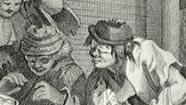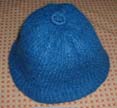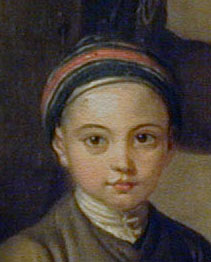|
|
 |
|
|
Knitted Caps Many of the surviving examples of 17th and 18th century caps (Rutt's Monmouth cap, the Gunnister caps and the Kilmarnock caul) were knitted larger than the finished size and then heavily felted to produce water-resistant headwear, though this treatment does not seem to have been universal (the caps from the HMS Invincible and the General Carleton of Whitby do not seem to have been felted). The term Monmouth Cap seems to refer generically to English knitted caps in the 18th century, some of which resemble Rutt's cap and others which are knitted at a much finer gauge. The Rutt-style Monmouth Cap (coarsely knitted) An original Monmouth cap of the Rutt type can be seen here -- this is probably the cap described by Buckland and Rutt: http://www.gtj.org.uk/en/item1/7998 It is likely that the original Monmouth cap in this picture had the brim knitted in two sections with a provisional cast-on; these sections would have been knitted together with a three-needle bind-off at the lower edge. The stitches from the cast-on edge would then have been picked up, knitted together in a process similar to that described above for knitting the edge of the brim to the body of the cap, and then the crown was knitted. This method seems rather awkward, and it is impossible to know from one surviving example whether this technique was typical or not. Hogarth's Industry and Idleness, Plate 3 shows two men wearing what could be Monmouth caps; one is striped: A round knitted cap is shown on p. 138 of Collector's Encyclopedia of the American Revolution by George Neumann. This cap is probably naval, since it is tarred (probably with Stockholm tar, which is light brown and dries fairly hard). Patterns for knitting this cap and the Machault-style cap, and documentation for both, can be found in The Packet II by Mark Tully. The rather coarse gauge of knitting appears to be similar to that in Rutt's Monmouth cap. Another coarsely knitted cap was found in the shipwreck of the HMS DeBraak (1798, Delware).
Similar caps show up frequently in English contexts as well through much of the 18th century. A boy is wearing a knitted cap (striped red, blue or black, and white)
in a picture
of a medical consultation by William Hoare, dated 1741 A cap from the 1758 wreck of the HMS Invincible of this type (deep crown, not hemispherical) is knitted in a light color; the original color is uncertain. It has stripes in a darker color around the crown, and has a pompom at the top. It is knitted in a finer gauge than the Rutt cap and does not appear to be felted (McGuane, p. 87). Zoffany's paintings of a scene from the comedy "The Provok'd Wife" (1763-64) and "The Porter and the Hare" (1784) both show Monmouth caps of this type. A striped cap like the ones above is in the collection of the Greensboro Historical Museum in Greensboro, North Carolina; it was purported to be worn by an officer named Forbis of the Guilford Militia at the Battle of Guilford Courthouse (1781). A cap knitted with a checkered pattern around the brim and crown (probably blue and white yarn), fringe at the brim, and a tassel on top, was found in the wreck of the General Carleton of Whitby (1785). (Babits) This style of cap continued into the 19th century -- Charles Wilson Peale shows one in his portrait of Mamout Yarrow, an old African man living in Georgetown in 1819. The Kilmarnock caul was similar to the caps described above, and was knitted in Kilmarnock and Stewarton, Scotland from about 1720 through the mid-19th century (Bennet, Scottish Knitting, p. 6-7). The Kilmarnock caul (undated) on p. 6 of Bennet's Scottish Knitting is bell-shaped or conical, knitted in a dark color with several horizontal stripes of a lighter color near the brim, and has checked two-color stranded knitting near the top of the cap, similar to the stranded knitting on the Gunnister pouch (late 17th century), and is heavily felted. The Machault Cap Machault cap, as knitted by the late Cindy Gorin of Port Tobacco Merchants, based on the directions in Mark Tully's The Packet II The Gunnister Caps (Scotland) Scots Bonnets 17th c. Scots bonnets were knitted with a brim and looked similar to the Tudor flat cap worn in the 16th and early to mid 17th century, from which it descends. The size of the brim diminished as the century wears on, disappearing entirely by early 18th century and leaving the bonnet in the beret-like form we know today. The most common color for these bonnets was blue, to the extent that the Scots blue bonnet became proverbial, though bonnets in other colors such as green, red, black, brown, and grey are documented. They were knitted to twice their finished size, heavily felted to their final shape and gauge, then shaved to render a smooth outer surface (Henshall, p. 2). A set of the large wooden knitting needles and belt used for bonnet knitting is shown in Bennet's Scottish Knitting. The dicing (checks) on the headband of Scottish bonnets doesn't appear until after the 1745 uprising, with the formation of Highland regiments in the British army. The bonnets described in Henshall's Early Textiles Found in Scotland are knitted at a gauge of 5.5 st./in. (Dava Moor, 1649) and 7 st./in. (Tarvie, probably later in the 17th c.). The cap shown in Bennet's Scottish Knitting, dated 1715, appears to be of a similar gauge. Some more recreations of 18th c. knitted caps: here and here |
|
Bennet, Helen. Scottish Knitting. Shire Album 164. Shire Publications Ltd., Cromwell House, Aylesbury, Bucks UK, c. 1986. Henshall, Audrey S. Early Textiles Found in Scotland and Stuart
Clothing and Other Articles from a late 17th Century Grave at Gunnister,
Shetland in the Proceedings
of the Society of Antiquaries of Scotland, Vol. 86, 1951-52. Neumann, George. Collector's Encyclopedia of the American Revolution. Pulliam, Deborah. Gunnister Man's Knitted Posessions, in Piecework, September/October 2002. Loveland, CO: Interweave Press. Rutt, Richard. A History of Hand Knitting. Tully, Mark, The Packet II, Being another collection of patterns, articles and essays of particular interest to the 18th-Century Re-Enactor. Ballindalloch Press, 2000 & 2003. Also see: Carlson, Jennifer, A Short History of the Monmouth Cap
|
|
|
|
|









